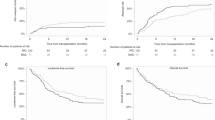Abstract
The conditioning regimens used for the allo-HSCT include either myeloablative conditioning (MAC) or reduced intensity conditioning (RIC) regimens based on the age, performance status and co-morbidities. Studies comparing the survival outcomes of RIC and MAC allo-HSCT in AML and MDS patients have reported contradictory results. We therefore retrospectively analyzed our data of AML and MDS patients who received MAC and RIC allo-HSCT at our center and compared the long term outcome of the two conditioning regimens. One hundred twenty six consecutive patients were evaluated, 32 (25.4%) underwent MAC allo-HSCT and 94 (74.6%) underwent RIC allo-HSCT. The most common MAC regimen used was busulfan plus cyclophosphamide and the most common RIC regimen used was fludarabine plus melphalan. The median age was higher in RIC group (44 years, range 4–75 years) compared to MAC group (31 yrs, range 6–51 yrs, p = 0.001). There was no significant difference in terms of overall survival (p = 0.498), relapse-free survival (p = 0.791) and non-relapse mortality (p = 0.366) between the two groups. In multivariate analysis, only chronic graft-versus-host disease resulted in decreased risk of relapse and improved overall survival irrespective of the conditioning regimens used.



Similar content being viewed by others
References
Wahid SFA (2013) Indications and outcomes of reduced-toxicity hematopoietic stem cell transplantation in adult patients with hematological malignancies. Int J Hematol 97(5):581–598
Horwitz ME (2011) Reduced intensity versus myeloablative allogeneic stem cell transplantation for the treatment of acute myeloid leukemia, myelodysplastic syndrome and acute lymphoid leukemia. Curr Opin Oncol 23(2):197–202
Bornhäuser M, Kienast J, Trenschel R, Burchert A, Hegenbart U, Stadler M et al (2012) Reduced-intensity conditioning versus standard conditioning before allogeneic haemopoietic cell transplantation in patients with acute myeloid leukaemia in first complete remission: a prospective, open-label randomised phase 3 trial. Lancet Oncol 13(10):1035–1044
Scott BL, Pasquini MC, Logan BR, Wu J, Devine SM, Porter DL et al (2017) Myeloablative versus reduced-intensity hematopoietic cell transplantation for acute myeloid leukemia and myelodysplastic syndromes. J Clin Oncol 35(11):1154–1161
Bacigalupo A, Ballen K, Rizzo D, Giralt S, Lazarus H, Ho V et al (2009) Defining the intensity of conditioning regimens: working definitions. Biol Blood Marrow Transpl 15(12):1628–1633
Filipovich AH, Weisdorf D, Pavletic S, Socie G, Wingard JR, Lee SJ et al (2005) National Institutes of Health consensus development project on criteria for clinical trials in chronic graft-versus-host disease: I. diagnosis and staging working group report. Biol Blood Marrow Transpl 11(12):945–956
Aoudjhane M, Labopin M, Gorin NC, Shimoni A, Ruutu T, Kolb H-J et al (2005) Comparative outcome of reduced intensity and myeloablative conditioning regimen in HLA identical sibling allogeneic haematopoietic stem cell transplantation for patients older than 50 years of age with acute myeloblastic leukaemia: a retrospective survey from the Acute Leukemia Working Party (ALWP) of the European group for Blood and Marrow Transplantation (EBMT). Leukemia 19(12):2304–2312
Luger SM, Ringdén O, Zhang M-J, Pérez WS, Bishop MR, Bornhauser M et al (2012) Similar outcomes using myeloablative vs reduced-intensity allogeneic transplant preparative regimens for AML or MDS. Bone Marrow Transpl 47(2):203–211
Goker H, Ozdemir E, Uz B, Buyukasik Y, Turgut M, Serefhanoglu S et al (2013) Comparative outcome of reduced intensity and myeloablative conditioning regimen in HLA identical sibling allogeneic hematopoietic stem cell transplantation for acute leukemia patients: a single center experience. Transfus Apher Sci 49(3):590–599
Valcárcel D, Martino R, Caballero D, Martin J, Ferra C, Nieto JB et al (2008) Sustained remissions of high-risk acute myeloid leukemia and myelodysplastic syndrome after reduced-intensity conditioning allogeneic hematopoietic transplantation: chronic graft-versus-host disease is the strongest factor improving survival. J Clin Oncol 26(4):577–584
Ganapule A, Nemani S, Korula A, Lakshmi KM, Abraham A et al (2017) Allogeneic stem cell transplant for acute myeloid leukemia: evolution of an effective strategy in India. J Glob Oncol 3(6):773–781
Abdul Wahid SF, Ismail N-A, Mohd-Idris M-R, Jamaluddin FW, Tumian N, Sze-Wei EY et al (2014) Comparison of reduced-intensity and myeloablative conditioning regimens for allogeneic hematopoietic stem cell transplantation in patients with acute myeloid leukemia and acute lymphoblastic leukemia: a meta-analysis. Stem Cells Dev 23(21):2535–2552
Kröger N, Iacobelli S, Franke G-N, Platzbecker U, Uddin R, Hübel K et al (2017) Dose- reduced versus standard conditioning followed by allogeneic stem-cell transplantation for patients with myelodysplastic syndrome: a prospective randomized phase III study of the EBMT (RICMAC Trial). J Clin Oncol 35(19):2157–2164
Sharma SK, Choudhary D, Kaul E, Kharya G, Khandelwal V, Kothari S et al (2016) Hematopoietic stem cell transplant in elderly patients: Experience from a tertiary care centre in Northern India. Indian J Hematol Blood Transfus 32:205–207
Acknowledgements
We are thankful to Ms Saheli and Ms Anubha for collecting and formatting the data.
Funding
There is no financial support for this study.
Author information
Authors and Affiliations
Corresponding author
Ethics declarations
Conflict of interest
The authors declare no conflict of interest.
Additional information
Publisher's Note
Springer Nature remains neutral with regard to jurisdictional claims in published maps and institutional affiliations.
Rights and permissions
About this article
Cite this article
Sharma, S.K., Choudhary, D., Doval, D. et al. Myeloablative Versus Reduced Intensity Conditioning Regimens for Allogeneic Hematopoietic Stem Cell Transplant for Acute Myeloid Leukemia and Myelodysplastic Syndrome: A Retrospective Analysis. Indian J Hematol Blood Transfus 37, 472–478 (2021). https://doi.org/10.1007/s12288-020-01386-6
Received:
Accepted:
Published:
Issue Date:
DOI: https://doi.org/10.1007/s12288-020-01386-6




